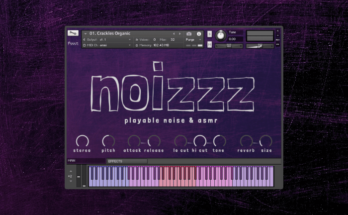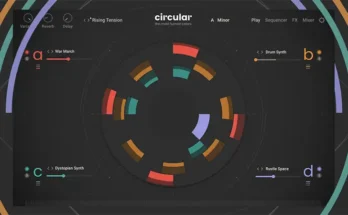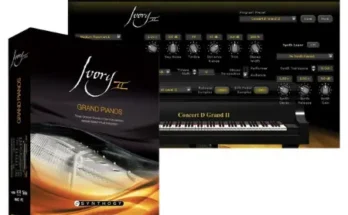TEAM MAGNETRiXX | 15 January 2013 | 2.21 GB
The goal of Groove Bias was to create a set of deeply sampled acoustic drum kits inspired by classic 50s, 60s and 70s records and the timeless breakbeats we all know and love. For decades, these sounds have been imitated and sampled over and over, but many producers have preferred to try and capture old kits with pristine, modern recording methods. Not so with this library. Our motto was “the more tubes, the better,” and we armed ourselves to the teeth with beat-up mics, analog gear, vintage drums and tape machines.

Groove Bias works in a wide range of genres thanks to the way we designed and recorded it. Sweeten it with some extra saturation (or pull up the appropriate preset) and it can provide the basis for a Chemical Brothers style big beat track. Tweak the low end and add a bit of vinyl buzz and you’ve got kit sound right out of “In a Gadda da Vida”. Set up your MPC and dial up the room mics and you’re creating classic drum breaks that are completely fresh. This is a library for people that love their drums.
We put over eight months of work into the meticulous recording and editing process, whole sessions going by before we were finally satisfied with a single snare sound. The result is what we think you’ll agree is the funkiest, “phattest” acoustic drum library around. We hope you enjoy Groove Bias!
The library contains nearly 4,000 samples (4 gigabytes) across three custom drum kits and a set of percussion. The audio content includes five snares, four kicks, nine toms, three hats (closed, loose, open, pedal), two rides, two crashes, two splashes, two rims, handclaps, tambourine, shaker, agogo, bongos, woodblocks, cowbell and triangle. Unlike the various enormous drum libraries out there, Groove Bias simplifies mixing, combining mics into single patches (though you often have access to separate overhead/room mixing, for example, to control natural reverb.)
Despite the lo-fidelity recording method and old-school gear used, all the audio for this project was dumped and edited from Pro Tools at 24-bit, 96 kHz. The samples (WAV format) are a mix of mono and stereo, where appropriate. Every single patch has a minimum of five round robins and five velocities, all the way up to sixteen velocities and ten round robins for some patches, such as some of the snares.
All formats of the library are basically divided into two primary patch types: component patches, which contain single parts of each kit, such as a single snare, and full kit patches, which contain an entire drumkit. The component patches allow the user to create a custom kit easily and swap parts in and out to their taste, while the full kit/multi patches provide a ready-mixed, quick start option.
The three custom kits of Groove Bias were recorded and performed in three studio locations across the United States, then chopped, tweaked and edited by Andrew Aversa of Impact Soundworks.
“Superfreak” (Milkboy Studios, Ardmore, PA)
As the name suggests, most of this 60s Ludwig ‘Silver Comet’ kit is rumored to have originally belonged to a certain funk music icon. The drums were recorded using high-end ribbon mics into an all-analog signal path, most notably a 70s Neve console with a few busted channels and lots of character. Outboard processors in the chain included gear by Empirical Labs, Tube-Tech, and Anthony DeMaria Labs. The saturation present on the higher velocities of some of the sounds, like the kick and snare, came solely from high gain running through all the tubes; no overdrive, distortion, or compressor saturation was applied!
“Tape” (The Audio Lab, Milville, NJ)
This one was a real hybrid, the centerpiece being a 30s Ludwig Pioneer Black Beauty snare. The kicks and toms were Tamburo original series, along with an extra 22” Tama kick. Our hats, cymbals and rides were a mishmash of faded, junked up old metal… just what we wanted. Everything in the kit was recorded through an analog signal path then finally to an authentic, 24-track Otari tape machine before being dumped into Pro Tools. Mics used for this kit ranged in age and manufacturer. Various workhorse mics from EV, Sennheiser, Shure and Audix were used throughout, and to get the trashy, crunchy room sound, we used a trashy 70s General Electric cassette recorder mic along with an RCA SK-30.
“Herodotus” (Real Music Media, Minneapolis, MN)
John Gump (a.k.a. KVRAudio member Herodotus) recorded this drum set, which is the same make and model as Cream drummer Ginger Baker’s drums! Mics used were a pair of Neumann KM-184s and Sennheiser 441s plus a Royer R-121. All of this went into some serious outboard gear like a classic UA 1176, Manley Labs VOXBOX, UA 2-610S and Manley Vari-Mu before finally going to a TASCAM reel-to-reel tape machine to seal the deal.
[toggle title=”Home page”]https://tinyurl.com/veps8r9[/toggle]

http://alfalink.to/e78f3568a3b69ce76e62
Please REPORT in Comment Broken Links




